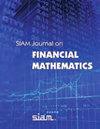Optimal Consumption Under a Habit-Formation Constraint: The Deterministic Case
IF 1.4
4区 经济学
Q3 BUSINESS, FINANCE
引用次数: 0
Abstract
We formulate and solve a deterministic optimal consumption problem to maximize the discounted constant relative risk aversion utility of an individual’s consumption-to-habit process assuming they only invest in a riskless market and that they are unwilling to consume at a rate below a certain proportion of their consumption habit. Increasing increases the degree of addictiveness of habit formation, with (respectively, ) corresponding to nonaddictive (respectively, completely addictive) model. We derive the optimal consumption policies explicitly in terms of the solution of a nonlinear free-boundary problem, which we analyze in detail. Impatient individuals (or, equivalently, those with more addictive habits) always consume above the minimum rate; thus, they eventually attain the minimum wealth-to-habit ratio. Patient individuals (or, equivalently, those with less addictive habits) consume at the minimum rate if their wealth-to-habit ratio is below a threshold and above it otherwise. By consuming patiently, these individuals maintain a wealth-to-habit ratio that is greater than the minimum acceptable level. Additionally, we prove that the optimal consumption path is hump-shaped if the initial wealth-to-habit ratio is either (1) larger than a high threshold or (2) below a low threshold and the agent is more risk seeking (that is, less risk averse). Thus, we provide a simple explanation for the consumption hump observed by various empirical studies.习惯形成约束下的最优消费:确定性情况
我们制定并解决了一个确定性最优消费问题,以最大化个人消费到习惯过程的贴现常数相对风险厌恶效用,假设他们只投资于无风险的市场,并且他们不愿意以低于其消费习惯的一定比例的速度消费。习惯形成的成瘾性程度越高,(分别)对应于非成瘾性(分别为完全成瘾性)模型。本文从一个非线性自由边界问题的解中导出了最优消费策略,并对其进行了详细的分析。没有耐心的人(或者,同样地,那些有上瘾习惯的人)总是消费超过最低水平;因此,他们最终达到了最小的财富与习惯之比。有耐心的人(或者,同样地,那些没有上瘾习惯的人),如果他们的财富与习惯之比低于阈值,则以最低的速度消费,否则高于阈值。通过耐心消费,这些人保持了财富与习惯的比率,这个比率大于最低可接受水平。此外,我们证明了最优消费路径是驼峰形的,如果初始财富与习惯比(1)大于一个高阈值或(2)低于一个低阈值,代理更倾向于风险寻求(即更少的风险厌恶)。因此,我们为各种实证研究观察到的消费驼峰提供了一个简单的解释。
本文章由计算机程序翻译,如有差异,请以英文原文为准。
求助全文
约1分钟内获得全文
求助全文
来源期刊

SIAM Journal on Financial Mathematics
MATHEMATICS, INTERDISCIPLINARY APPLICATIONS-
CiteScore
2.30
自引率
10.00%
发文量
52
期刊介绍:
SIAM Journal on Financial Mathematics (SIFIN) addresses theoretical developments in financial mathematics as well as breakthroughs in the computational challenges they encompass. The journal provides a common platform for scholars interested in the mathematical theory of finance as well as practitioners interested in rigorous treatments of the scientific computational issues related to implementation. On the theoretical side, the journal publishes articles with demonstrable mathematical developments motivated by models of modern finance. On the computational side, it publishes articles introducing new methods and algorithms representing significant (as opposed to incremental) improvements on the existing state of affairs of modern numerical implementations of applied financial mathematics.
 求助内容:
求助内容: 应助结果提醒方式:
应助结果提醒方式:


